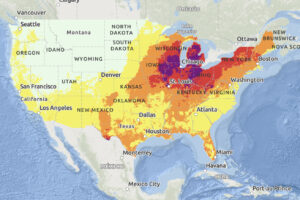
Extreme heat is in store for communities across the US this week, and the CDC and National Weather Service (NWS) have new tools to help people prepare for the health risks.

Heat is the top weather-related killer in the US, a threat that’s growing worse with climate change. But even though heatwaves kill some 1,220 people in the US, according to the CDC, the health risks can often fly under the radar. Heatwaves don’t necessarily illicit the same sense of urgency as tropical storms, for instance, which are named and categorized according to their intensity.
This year, it’s easier to see how any impending heat spell might impact your area thanks to HeatRisk tools launched by the CDC and NWS this year. You can head over to theHeatRisk dashboard and plug in your zip code to see forecasts and health recommendations for your area. For a bigger picture of how heat is impacting the US, check out a still experimental HeatRisk forecast online tool with a new color-coded system for assessing health risks.
“With hurricanes and tornadoes, those might get much more attention because you can visibly see the damage that occurs. But with heat, it’s a lot harder to actually see the impact unless it happens to impact you,” says Jessica Lee, NWS public weather services program coordinator. “The main thing we hope to accomplish with HeatRisk is that it will be used by individuals to help them personalize what forecasted heat will mean to them and better understand what actions they may need to take.”
More than 72.9 million people — over a fifth of the population — are under active heat advisories as a record-breaking heatwave is forecast to unfold across much of the Central US and Northeast this week. Open up the National Weather Service’s HeatRisk tool, and you’ll see a map of the contiguous US ablaze in yellow, orange, red, and magenta colors. Each color is a warning about the potential impacts heat is expected to have in a particular location each day of the week.
Disclaimer
The information contained in South Florida Reporter is for general information purposes only.
The South Florida Reporter assumes no responsibility for errors or omissions in the contents of the Service.
In no event shall the South Florida Reporter be liable for any special, direct, indirect, consequential, or incidental damages or any damages whatsoever, whether in an action of contract, negligence or other tort, arising out of or in connection with the use of the Service or the contents of the Service. The Company reserves the right to make additions, deletions, or modifications to the contents of the Service at any time without prior notice.
The Company does not warrant that the Service is free of viruses or other harmful components
This article originally appeared here and was republished with permission.












